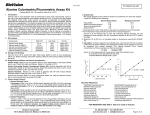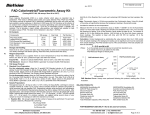Download PDF BioVision
Transcript
BioVision For research use only rev. 07/13 Citrate Colorimetric/Fluorometric Assay Kit I. II. (Catalog #K655-100; 100 assays; Store Kit at -20°C) Introduction: Citric acid (HOOC-CH2-C(-OH)(-COOH)-CH2-COOH) is a key intermediate in the TCA cycle which occurs in mitochondria. It is formed by the addition of oxaloacetate to the acetyl group of acetyl-CoA derived from the glycolytic pathway. Citrate can be transported out of mitochondria and converted back to acetyl CoA for fatty acid synthesis. Citrate is an allosteric modulator of both fatty acid synthesis (acetyl-CoA carboxylase) and glycolysis (phosphofructokinase). Citrate is widely used industrially in foods, beverages and pharmaceuticals. Citrate metabolism and disposition can vary widely due to sex, age and a variety of other factors. BioVision's Citrate Assay Kit provides a simple, sensitive and rapid means of quantifying citrate in a variety of samples. In the assay, citrate is converted to pyruvate via oxaloacetate. The pyruvate is quantified by converting a nearly colorless probe to an intensely colored (λmax=570 nm) and fluorescent (Ex/Em, 535/587 nm) product. The Citrate Assay Kit can detect 0.1 to 10 nmoles (~2 µM-10 mM) of citrate in a variety of samples. Kit Contents: 3. Develop: Mix enough reagent for the number of samples and standards to be performed: For each well, prepare a total 50 µl Reaction Mix containing: Colorimetric Assay Fluorometric Assay Sample Bkgd Control* Sample Bkgd Control* 4. Components K655-100 Cap Code Part Number Citrate Assay Buffer Citrate Probe Citrate Enzyme Mix Citrate Developer Citrate Standard (10 µmol) 25 ml 0.2 ml lyophilized lyophilized lyophilized WM Red Purple Green Yellow K655-100-1 K655-100-2 K655-100-3 K655-100-4 K655-100-5 III. Storage and Handling: Store kit at –20°C, protect from light. Warm Citrate Assay Buffer to room temperature before use. Briefly centrifuge all small vials prior to opening. IV. Reagent Preparation and Storage Conditions: Citrate Probe: Ready to use as supplied. Warm to 37°C for 1 – 2 min to completely melt the DMSO solution before use. Store at –20°C, protect from light. Use within two months. Citrate Developer, Enzyme Mix: Dissolve with 220 µl Assay Buffer separately. Pipette up and down to dissolve. Aliquot into portions, store at –20°C. Avoid repeated freeze/thaw cycles. Use within 2 months. Citrate Standard: Dissolve in 100 µl dH2O to generate 100 mM (100 nmol/µl) Citrate Standard solution. Keep on ice while in use. Store at -20°C. V. Assay Protocol: 1. Standard Curve Preparations: Colorimetric Assay: Dilute the Citrate Standard to 1 nmol/µl by adding 10 µl of the Standard to 990 µl of dH2O, mix well. Add 0, 2, 4, 6, 8, 10 µl into a series of standards wells on a 96 well plate. Adjust volume to 50 µl/well with Assay Buffer to generate 0, 2, 4, 6, 8, 10 nmol/well of the Standard. Fluorometric Assay: Dilute the Citrate standard to 0.1 nmol/µl by adding 10 µl of the standard to 990 µl of dH2O, mix well, then further dilute by adding 10 µl to 90 µl of dH2O. Add 0, 2, 4, 6, 8, 10 µl into a series of standards wells on a 96-well plate. Adjust the volume to 50 µl/well to generate 0, 0.2, 0.4, 0.6, 0.8, 1.0 nmol/well. 2. Sample Preparation: 6 Tissue (20 mg) or cells (2 x 10 ) should be rapidly homogenized with 100 µl of Citrate Assay Buffer. Centrifuge at 15,000 g for 10 min to remove cell debris. Enzymes in samples may interfere with the assay. We suggest deproteinizing samples using a perchloric acid/KOH protocol (BioVision, Cat. #K808-200) or 10 kDa molecular weight cut off spin columns (BioVision, Cat # 1997-25). Add 1-50 µl sample into duplicate wells of a 96-well plate and bring volume to 50 µl with Assay Buffer. We suggest testing several doses of your samples to ensure readings are within the standard curve range. BioVision Research Products 155 South Milpitas Boulevard, Milpitas, CA 95035 44 µl 2 µl 2 µl 2 µl Citrate Assay Buffer Citrate Enzyme Mix Developer Citrate Probe** 5. 6. 7. 46 µl ---2 µl 2 µl 44 µl 2 µl 2 µl 2 µl 46 µl ---2 µl 2 µl *Samples may contain oxaloacetate or pyruvate which can generate a background and need to be subtracted from the sample background signal. **For the fluorometric assay, dilute 10X with DMSO to reduce fluorescent background. Add 50 µl of the Reaction Mix to each well containing the Citrate Standard and test samples. Add 50 µl of the sample background control mix to background control wells. Incubate for 30 min at room temperature, protect from light. Measure OD at 570 nm or fluorescence at Ex/Em 535/587nm. Calculation: Correct background by subtracting the value of the 0 Citrate Standard from all readings. Next subtract the value of the Sample Background Control from the test sample. Plot the standard curve. Apply corrected sample readings to the standard curve to get Citrate amount in the sample wells. The Citrate concentration in the test samples equals: C = Ay/Sv (nmol/µ µl; or µmol/ml; or mM) Where: Ay is the amount of citrate (nmol) in your sample from the standard curve. Sv is the sample volume (µl) added to the sample well. Citric acid molecular weight: 191 g/mol. Citrate standard curve generated using this kit protocol VI. RELATED PRODUCTS: ADP/ATP Kit CoA/Acetyl CoA Assay Kits Malic Acid Assay Kit α-Ketoglutarate Assay Kit Malic Acid Assay Kit Isocitrate Assay Kit Starch Assay Kit Pyruvate Assay Kit NAD/NADH and NADP/NADPH Assay Kits Pyruvate Assay Kit Glutamate Assay Kit Lactate Assay Kits Oxaloacetate Assay Kit Glycogen Assay Kit Glucose Assay Kit Maltose Assay Kit Tel: 408-493-1800 • Fax: 408-493-1801 • www.biovision.com Email: [email protected] Page 1 of 2 BioVision For research use only rev. 07/13 GENERAL TROUBLESHOOTING GUIDE: Problems Cause Solution Assay not working • Use of ice-cold assay buffer • Assay buffer must be at room temperature Samples with erratic readings Lower/ Higher readings in Samples and Standards Readings do not follow a linear pattern for Standard curve Unanticipated results • Omission of a step in the protocol • Refer and follow the data sheet precisely • Plate read at incorrect wavelength • Check the wavelength in the data sheet and the filter settings of the instrument • Use of a different 96-well plate • Fluorescence: Black plates (clear bottoms) ; Luminescence: White plates ; Colorimeters: Clear plates • Use of an incompatible sample type • Refer data sheet for details about incompatible samples • Samples prepared in a different buffer • Use the assay buffer provided in the kit or refer data sheet for instructions • Samples were not deproteinized (if indicated in datasheet) • Use the 10 kDa spin cut-off filter or PCA precipitation as indicated • Cell/ tissue samples were not completely homogenized • Use Dounce homogenizer (increase the number of strokes); observe for lysis under microscope • Samples used after multiple free-thaw cycles • Aliquot and freeze samples if needed to use multiple times • Presence of interfering substance in the sample • Troubleshoot if needed, deproteinize samples • Use of old or inappropriately stored samples • Use fresh samples or store at correct temperatures till use • Improperly thawed components • Thaw all components completely and mix gently before use • Use of expired kit or improperly stored reagents • Always check the expiry date and store the components appropriately • Allowing the reagents to sit for extended times on ice • Always thaw and prepare fresh reaction mix before use • Incorrect incubation times or temperatures • Refer datasheet & verify correct incubation times and temperatures • Incorrect volumes used • Use calibrated pipettes and aliquot correctly • Use of partially thawed components • Thaw and resuspend all components before preparing the reaction mix • Pipetting errors in the standard • Avoid pipetting small volumes • Pipetting errors in the reaction mix • Prepare a master reaction mix whenever possible • Air bubbles formed in well • Pipette gently against the wall of the tubes • Standard stock is at an incorrect concentration • Always refer the dilutions in the data sheet • Calculation errors • Recheck calculations after referring the data sheet • Substituting reagents from older kits/ lots • Use fresh components from the same kit • Measured at incorrect wavelength • Check the equipment and the filter setting • Samples contain interfering substances • Troubleshoot if it interferes with the kit • Use of incompatible sample type • Refer data sheet to check if sample is compatible with the kit or optimization is needed • Sample readings above/below the linear range • Concentrate/ Dilute sample so as to be in the linear range Note# The most probable list of causes is under each problem section. Causes/ Solutions may overlap with other problems. BioVision Research Products 155 South Milpitas Boulevard, Milpitas, CA 95035 Tel: 408-493-1800 • Fax: 408-493-1801 • www.biovision.com Email: [email protected] Page 2 of 2



